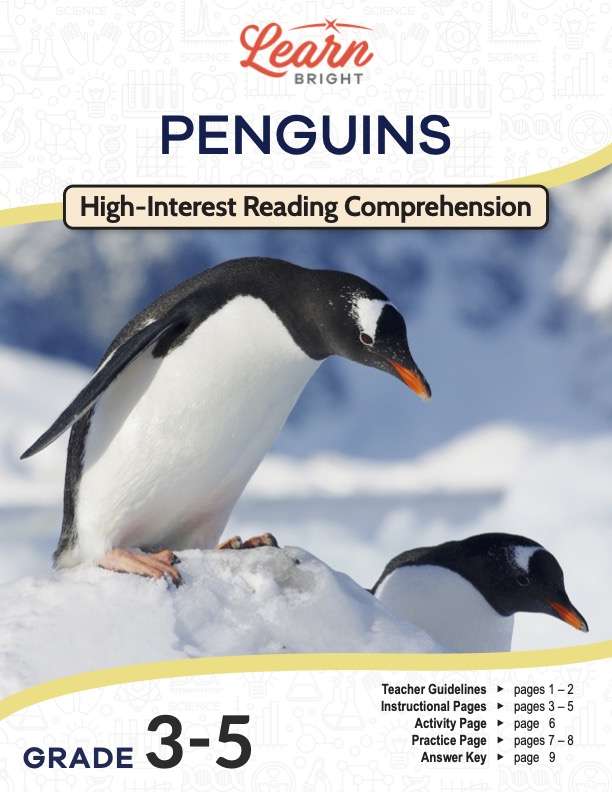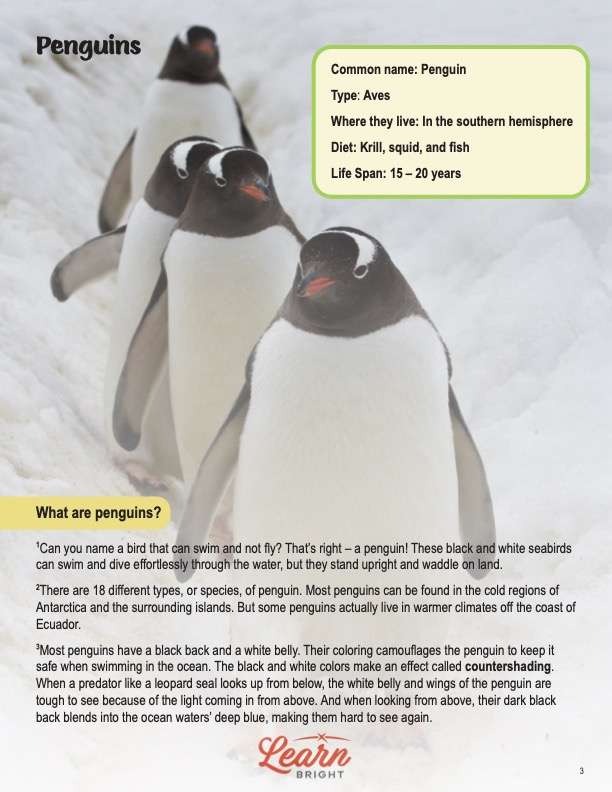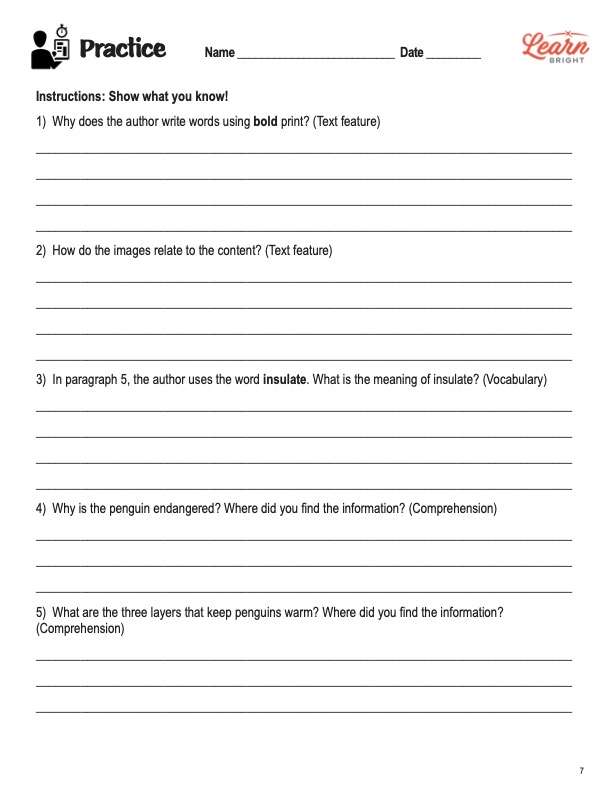Description
What our Penguins lesson plan includes
Lesson Objectives and Overview: Penguins is a high-interest reading comprehension lesson plan. As such, students will practice various close reading and comprehension skills. In addition, they will learn about the habitat, diet, and behaviors of these unique birds. This lesson is for students in 3rd grade, 4th grade, and 5th grade.
Classroom Procedure
Every lesson plan provides you with a classroom procedure page that outlines a step-by-step guide to follow. You do not have to follow the guide exactly. The guide helps you organize the lesson and details when to hand out worksheets. It also lists information in the yellow box that you might find useful. You will find the lesson objectives, state standards, and number of class sessions the lesson should take to complete in this area. In addition, it describes the supplies you will need as well as what and how you need to prepare beforehand.
Teacher Notes
The paragraph on this page provides a little more information or guidance on what to expect from the lesson. It explains that you can teach this lesson in a whole-class setting or to an independent, small group as an activity. You can use the blank lines to record any thoughts or ideas you have as you prepare.
PENGUINS LESSON PLAN CONTENT PAGES
What Are Penguins?
The Penguins lesson plan contains three content pages. It begins by providing a box of background information about this animal. Penguins live in the southern hemisphere and eat krill, squid, and fish. They live for between 15 and 20 years.
These black and white seabirds can swim and dive effortlessly through the water, but they stand upright and waddle on land. There are 18 different types, or species, of penguin. Most penguins can be found in the cold regions of Antarctica and the surrounding islands. But some penguins actually live in warmer climates off the coast of Ecuador.
Most penguins have a black back and a white belly. Their coloring camouflages them to keep them safe when swimming in the ocean. The black and white colors create an effect called countershading. When a predator such as a leopard seal looks up from below, the white belly and wings of the penguin are tough to see because of the light coming in from above. And when looking from above, their dark black back blends into the ocean waters’ deep blue, making them hard to see again.
Depending on the type of penguin, they can range in height from one to four feet tall. They use their short, paddle-like wings and webbed feet for swimming. Their bodies are like a torpedo shooting through the water. Penguins can swim more than 25 miles an hour, but they are much slower on land. While their short legs can dash on the ice and snow, it is much faster for them to slide on their bellies.
Students will learn that penguins can stay warm in cold temperatures because they have a thick layer of blubber. The blubber insulates them, protecting them from losing heat. They also have two layers of feathers. The lower layer is made of wooly down feathers that are coated with a type of oil that makes them waterproof. The upper layer of feathers is very short. Their outer short, veined feathers pack tightly together to create another layer of cover by trapping warm air.
Penguin Diet, Facts, and Importance
Penguins eat different types of small fishes, squid, krill, and other ocean animals. But as delicious as fish is, scientists discovered penguins cannot taste fish. This is because they are missing essential genes, which are units of heredity a parent passes to its offspring. When scientists closely examined the DNA of the penguins, they discovered that penguins cannot taste sweet, bitter, or umami flavors. But it doesn’t matter to the penguins because they swallow their food whole!
The lesson then lists six interesting facts about penguins. If we run across a group of penguins in the water, we call the group a raft. If we see them on land, however, we call the group a waddle. There are no penguins at the North Pole. They have extraordinary lung capacity. Some can hold their breath for up to 22 minutes straight! In addition, emperor penguins can dive very deep underwater, up to nearly 2,000 feet!
Right now, penguins struggle to battle climate change, overfishing, and pollution in the ocean. At the same time, they have to deal with habitat destruction, new predators, and human disturbances on the land. In addition, as their food supply dwindles, they have to go further and further out to find food, making them more susceptible to dangers.
Some species of penguin are endangered, like the yellow-eyed penguin. Only about 4,000 of these birds remain. The erect-crested penguin has lost over 70% of its population in the last 20 years alone. As the ice melts due to warming and as fishing boats strip the ocean of a vital food source, penguins around the globe suffer.
PENGUINS LESSON PLAN WORKSHEETS
The Penguins lesson plan includes two worksheets: an activity worksheet and a practice worksheet. Each one will help students solidify their grasp of the material they learned throughout the lesson. You can refer to the classroom procedure guidelines to know when to hand out each worksheet.
SAVE THE PENGUIN ACTIVITY WORKSHEET
The activity page includes two separate activities. Students will work as a team for both. First, they will read the prompt to learn about the problem with baby penguins’ exposure to rain too early. They must work as a team to create something we could use to assist penguin parents or babies. Students must describe their invention, including how they will make it, what materials they will use, and how to get it to the penguin population. In addition, they must include a drawing or image of their invention.
For the second activity, the teams (same or different) will create a presentation using slideshow presentation software. Their presentation must explain the plight of the penguin population. It must also describe the team’s solutions to help more young penguins survive in the wild.
CONTENT REVIEW PRACTICE WORKSHEET
The practice worksheet lists 11 questions based on the content. These questions all relate to the content pages, so students will need to refer to them often for the answers. In addition, each question provides which reading tool the question corresponds to, such as text feature, vocabulary, or comprehension.
Worksheet Answer Keys
At the end of the lesson plan document is an answer key for the practice worksheet. The correct answers are all in red to make it easier for you to compare them with students’ responses. If you choose to administer the lesson pages to your students via PDF, you will need to save a new file that omits these pages. Otherwise, you can simply print out the applicable pages and keep these as reference for yourself when grading assignments.










